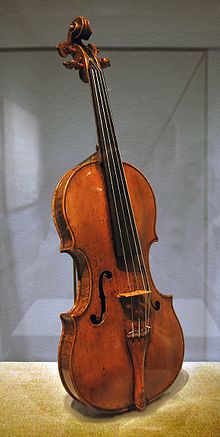
 |
| Part of a series on |
| Violin |
|---|
| Violinists |
| Fiddle |
| Fiddlers |
| History |
| Musical styles |
| Technique |
| Acoustics |
| Construction |
| Luthiers |
| Family |
Violin acoustics is an area of study within musical acoustics concerned with how the sound of a violin is created as the result of interactions between its many parts. These acoustic qualities are similar to those of other members of the violin family, such as the viola.
The energy of a vibrating string is transmitted through the bridge to the body of the violin, which allows the sound to radiate into the surrounding air. Both ends of a violin string are effectively stationary, allowing for the creation of standing waves. A range of simultaneously produced harmonics each affect the timbre, but only the fundamental frequency is heard. The frequency of a note can be raised by the increasing the string's tension, or decreasing its length or mass. The number of harmonics present in the tone can be reduced, for instance by the using the left hand to shorten the string length. The loudness and timbre of each of the strings is not the same, and the material used affects sound quality and ease of articulation. Violin strings were originally made from catgut but are now usually made of steel or a synthetic material. Most strings are wound with metal to increase their mass while avoiding excess thickness.
During a bow stroke, the string is pulled until the string's tension causes it to return, after which it receives energy again from the bow. Violin players can control bow speed, the force used, the position of the bow on the string, and the amount of hair in contact with the string. The static forces acting on the bridge, which supports one end of the strings' playing length, are large: dynamic forces acting on the bridge force it to rock back and forth, which causes the vibrations from the strings to be transmitted. A violin's body is strong enough to resist the tension from the strings, but also light enough to vibrate properly. It is made of two arched wooden plates with ribs around the sides and has two f-holes on either side of the bridge. It acts as a sound box to couple the vibration of strings to the surrounding air, with the different parts of the body all respond differently to the notes that are played, and every part (including the bass bar concealed inside) contributing to the violin's characteristic sound. In comparison to when a string is bowed, a plucked string dampens more quickly.
The other members of the violin family have different, but similar timbres. The viola and the double bass’s characteristics contribute to them being used less in the orchestra as solo instruments, in contrast to the cello (violoncello), which is not adversely affected by having the optimum dimensions to correspond with the pitch of its open strings.
© MMXXIII Rich X Search. We shall prevail. All rights reserved. Rich X Search
